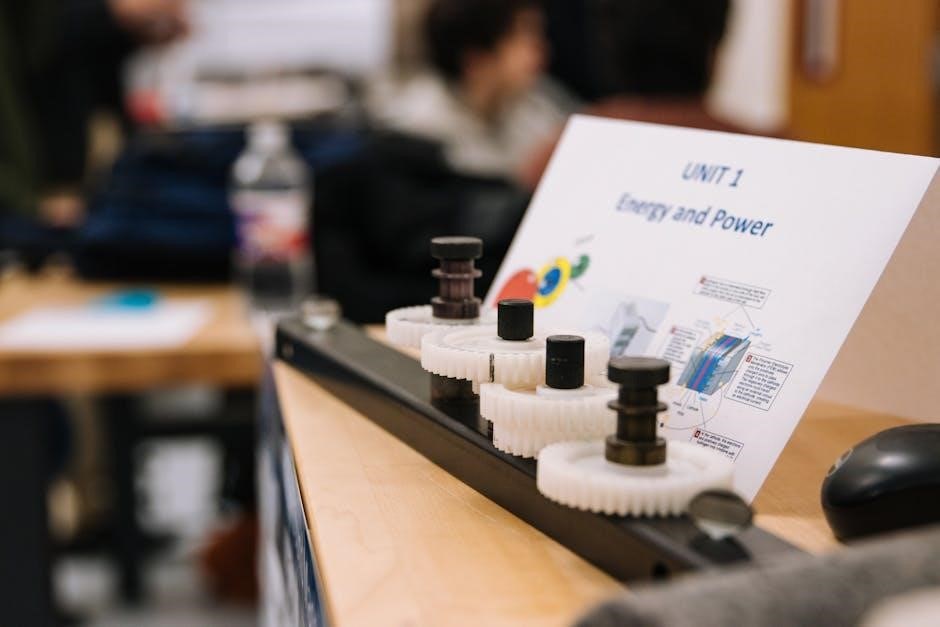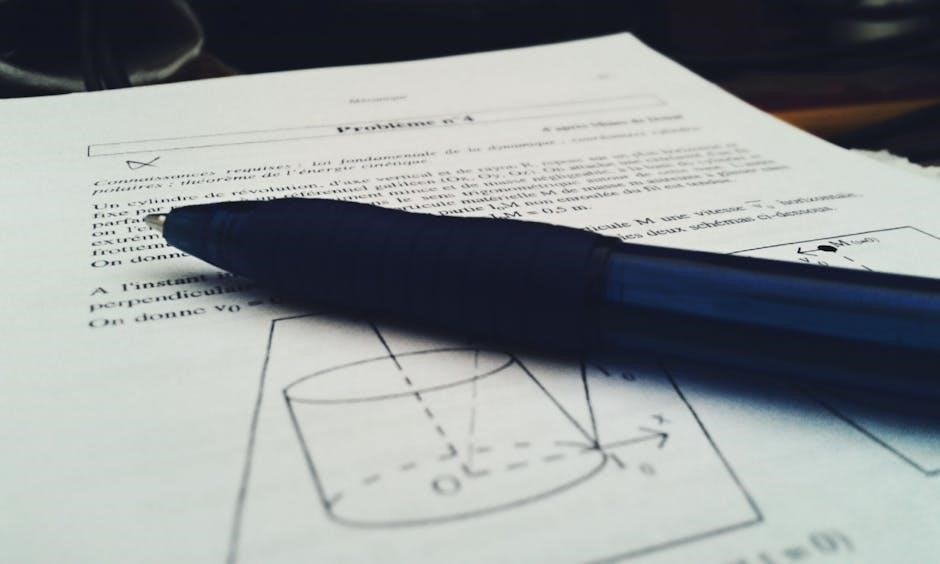AP Physics C: Mechanics Study Guide
This guide offers preparatory information for the AP Physics C: Mechanics exam and beyond! It aids in reviewing concepts, problem-solving, and accessing resources. It also helps in connecting with fellow students.
Exam Overview
The AP Physics C: Mechanics exam is designed to assess your understanding of mechanics principles and your ability to apply them using calculus. This exam is a rigorous assessment intended for students who have completed or are completing a calculus-based physics course. Success requires not only a strong grasp of concepts but also proficiency in problem-solving and mathematical manipulation.
The exam typically consists of two sections: a multiple-choice section and a free-response section. The multiple-choice section tests your conceptual understanding and ability to quickly apply formulas. The free-response section requires you to solve more complex problems, demonstrating your problem-solving process and reasoning skills. Mastery of kinematics, Newton’s laws, work, energy, power, systems of particles, linear momentum, rotational motion, and oscillations is essential for success.

Core Concepts
The foundations of mechanics are explored here! Key principles like kinematics, dynamics, energy, and momentum will be covered. These concepts are crucial for a strong understanding of AP Physics C: Mechanics.
Kinematics
Kinematics is the study of motion without considering the forces that cause it; It involves understanding displacement, velocity, and acceleration. Mastering uniformly accelerated motion equations is crucial. Vectors and scalars also play a vital role in describing motion accurately. Projectile motion, a key application of kinematics, requires analyzing horizontal and vertical components of velocity and acceleration.
Kinematics forms the basis for understanding more complex concepts in mechanics. Analyzing motion in one dimension is the foundation! Then you can move on to two dimensions. Understanding graphs of position, velocity, and acceleration versus time is essential for interpreting motion. Kinematics provides the tools to describe and predict the motion of objects.
Being able to visualize and analyze motion is vital.
Newton’s Laws of Motion
Newton’s Laws of Motion are fundamental to understanding dynamics. The first law describes inertia: an object at rest stays at rest, and an object in motion stays in motion with the same speed and direction unless acted upon by a force. The second law relates force, mass, and acceleration (F = ma). The third law states that for every action, there is an equal and opposite reaction.
These laws are applied in various scenarios, including free-body diagrams. Free-body diagrams are important for analyzing forces acting on an object. Understanding friction (static and kinetic) is essential for problem-solving. Applying Newton’s Laws to systems of objects requires careful analysis of internal and external forces.
These laws provide the foundation for understanding how forces affect the motion of objects;
Work, Energy, and Power
Work, energy, and power are interconnected concepts. Work is the transfer of energy, often defined as force times displacement (W = Fdcosθ). Energy exists in various forms: kinetic, potential (gravitational and elastic), and thermal. The work-energy theorem states that the net work done on an object equals its change in kinetic energy.
Power is the rate at which work is done (P = W/t) or the rate at which energy is transferred. Understanding conservative and non-conservative forces is crucial. Conservative forces, like gravity, have associated potential energies. Non-conservative forces, like friction, dissipate energy as heat. Conservation of energy is a fundamental principle.
Calculations involving changes in kinetic energy and potential energy are common.
Systems of Particles and Linear Momentum
A system of particles involves multiple interacting objects. The center of mass (COM) represents the average position of the system’s mass. The total linear momentum of a system is the vector sum of the individual momenta of its particles. Impulse, the change in momentum, is equal to the force applied over a time interval.
Conservation of linear momentum is crucial when the net external force on the system is zero. Collisions are interactions where momentum is transferred. In elastic collisions, both momentum and kinetic energy are conserved. In inelastic collisions, only momentum is conserved; kinetic energy is lost, often as heat or deformation.
Calculations involving changes in momentum, kinetic energy, and energy loss are vital.

Rotational Motion
This section explores rotational kinematics, dynamics, and angular momentum. It includes topics like moment of inertia, torque, and conservation of angular momentum, essential for understanding rotating systems.
Rotational Kinematics
Rotational kinematics mirrors linear kinematics but deals with angular quantities. Key concepts include angular displacement (θ), angular velocity (ω), and angular acceleration (α). These are related by equations analogous to those in linear motion, such as ω = ω₀ + αt and θ = ω₀t + ½αt². Understanding these relationships is crucial for analyzing the motion of rotating objects.
Problems often involve calculating angular displacement, velocity, or acceleration given certain conditions. Pay attention to the direction of rotation and use the right-hand rule to determine the direction of angular velocity and angular acceleration vectors. Remember to convert between radians and degrees when necessary. Mastering these concepts is vital for success.
Also, understanding the relationship between linear and angular variables, like v = rω and a = rα, is essential for solving problems involving rolling motion.
Rotational Dynamics
Rotational dynamics explores the causes of rotational motion, primarily torque and moment of inertia. Torque (τ) is the rotational equivalent of force, defined as τ = rFsinθ, where r is the distance from the axis of rotation and θ is the angle between r and F. Moment of inertia (I) is the resistance to rotational motion, analogous to mass in linear motion.
Newton’s second law for rotation is τ = Iα, where α is angular acceleration. This equation is fundamental for solving problems involving rotational dynamics. The moment of inertia depends on the object’s mass distribution and the axis of rotation. Common shapes have specific formulas for I, which you should familiarize yourself with.
Understanding how to calculate torque and moment of inertia is key to analyzing rotational systems. Remember to consider all torques acting on an object and their directions.
Angular Momentum
Angular momentum (L) is a measure of an object’s rotational inertia and rotational velocity. For a point particle, L = r × p = r × mv, where r is the position vector from the axis of rotation, p is linear momentum, m is mass, and v is velocity. For a rigid body, L = Iω, where I is the moment of inertia and ω is the angular velocity;
The law of conservation of angular momentum states that in the absence of external torques, the total angular momentum of a system remains constant. This principle is crucial for solving problems involving collisions and changes in rotational motion.
Remember that angular momentum is a vector quantity with both magnitude and direction. The direction is determined by the right-hand rule. Understanding angular momentum is essential to succeeding in physics.

Oscillations
Oscillations explore periodic motion, a fundamental concept in physics. The main focus is understanding simple harmonic motion and its applications. Grasping these principles is crucial for exam success.
Simple Harmonic Motion
Simple Harmonic Motion (SHM) is a crucial topic within oscillations, involving periodic motion where the restoring force is proportional to the displacement. Key concepts include displacement, velocity, acceleration, amplitude, frequency, and period. Understanding the relationship between these parameters is vital.
Mastering SHM requires familiarity with equations governing motion, energy, and the influence of external forces. Analyzing systems like springs and pendulums helps solidify understanding. The energy conservation principle is essential in SHM problems.
Additionally, explore graphical representations of SHM to visualize relationships between displacement, velocity, and acceleration over time. Grasping these graphical connections aids in conceptual understanding and problem-solving. Practice diverse problems involving SHM to develop proficiency.
Furthermore, remember to analyze scenarios with damped or driven oscillations to fully comprehend the behavior of these systems. Understanding these aspects is really important.

Tips and Strategies
To succeed in AP Physics C: Mechanics, employ effective problem-solving techniques. Utilize available review resources and study guides, and learn to connect with other students who are also studying for the exam.
Problem-Solving Techniques
Mastering problem-solving is crucial for success in AP Physics C: Mechanics. A robust approach involves a clear understanding of the underlying physics principles and their application to specific scenarios. Start by carefully reading and analyzing the problem statement, identifying knowns, unknowns, and relevant concepts. Draw diagrams or free-body diagrams to visualize the situation, which aids in understanding forces and motion.
Next, select appropriate formulas and equations based on the identified concepts, ensuring that units are consistent. Solve the equations algebraically before plugging in numerical values to minimize errors. After obtaining a solution, critically evaluate its reasonableness and units. Practice diverse problems to enhance pattern recognition and build confidence. Collaborate with peers and seek guidance from teachers to clarify doubts and refine your problem-solving skills. Remember, consistent practice and a methodical approach are key to mastering problem-solving in AP Physics C: Mechanics.
Review Resources
To effectively prepare for the AP Physics C: Mechanics exam, utilizing diverse review resources is essential. Start with textbooks and study guides that provide comprehensive coverage of core concepts, formulas, and problem-solving techniques. Online platforms like Flipping Physics and Khan Academy offer video lectures and practice problems, which can supplement textbook learning.
AP Physics C review books, such as those from Barron’s and Princeton Review, provide targeted content review and practice tests aligned with the exam format. Past AP Physics C: Mechanics free-response questions (FRQs) and multiple-choice questions (MCQs) are invaluable for exam preparation. Engaging with online communities and forums allows students to collaborate, ask questions, and share insights. By combining these resources, students can create a well-rounded review strategy to maximize their understanding and exam performance.
